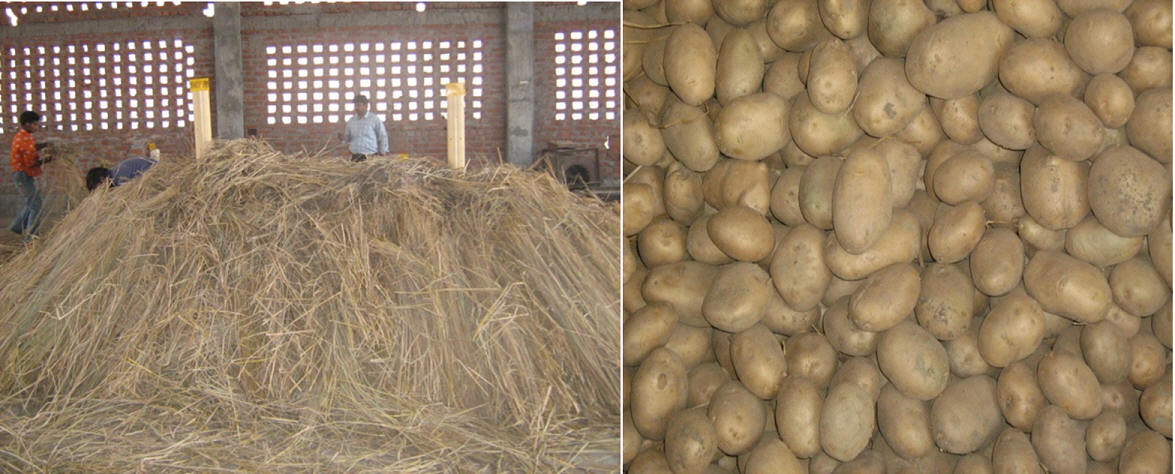
A modified heap and potatoes after removal (treated with CIPC)
Non-refrigerated storage of potatoes:
The infrastructure for refrigerated storage in the country is unevenly distributed and sometimes it is beyond the reach of small and marginal farmers. In many states the storage facility is either lacking or is not adequate to accommodate the ware/seed potatoes. Many farmers in these states use indigenous storage practices like pits, heaps, trenches and basements to hold some of their produce for short-term to fetch better prices during off-season. Though these on-farm storage methods are economical and practical, they are not efficient because of higher losses due to increased rotting (10-21%). Therefore, improvements were done in the traditional storage practices, particularly, potato heaps as a part of marketing strategy to increase remunerations from potato cultivation by holding the produce on-farm for short periods (3-4 months) and to bypass the immediate post-harvest period when the prices are the lowest.
Improved heaps help to reduce the daily range of variation in temperatures while maintaining a high relative humidity (RH). While the day time variation in ambient temperature and relative humidity is considerable, the atmosphere inside the heap is quite stable. Minimum-maximum temperatures in the heap during storage (March to June) ranges between 13-30°C as compared to 8-44°C of the ambient and RH remains consistently high (60-95%) compared to wide variation and lower levels (27-87%) of the ambient as observed during experimentation. Weight loss and rottage are significantly reduced (<10%) in potatoes stored in heaps as compared to those stored at room temperature. Weight loss up to 10% is considered acceptable because no visible shriveling takes place up to this level, the stored potatoes remain firm and desprouted potatoes fetch prices comparable to the cold stored potatoes, which are 40-50% higher than that at the time of harvest. Treatment of potatoes with sprout suppressants before heap storage has been found to reduce the losses further.
|
|
|
A modified heap and potatoes after removal (treated with CIPC) |
Physiological and pathological losses in potatoes are higher under non-refrigerated conditions therefore, appropriate pre and post-harvest measures are to be strictly followed for successful storage in heaps as described previously. Storage in heaps may be completed by the end of February so that the lower temperatures prevailing during this period can be taken advantage of. Heaps may be protected from unseasonal rains either by erecting a thatched roof or covering with a water proof sheet. If a water proof sheet is used, it needs to be removed after the rain stops. Stored potatoes may be sent to the market before the temperatures inside the heaps reaches 30°C.
Potatoes stored in heaps are highly suitable for processing due to low reducing sugar content. These are also not sweet in taste and are more preferred as table potatoes. Therefore, the prices fetched by these potatoes in markets as table potatoes are also more than the cold stored potatoes.